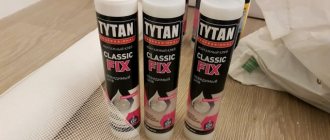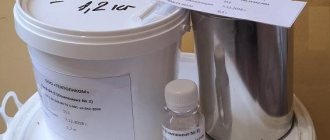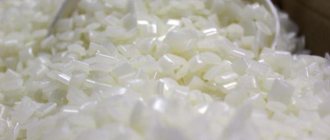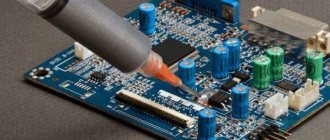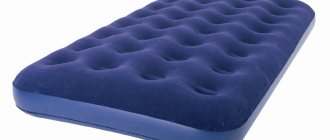Breakage of plastic connections is a fairly common situation. At the same time, you should not rush to buy a new part; it is likely that plastic glue will help solve this problem.
It should be noted here that there are quite a lot of substances of this type, so deciding on a specific option is not so easy. In this article we will talk about how to glue plastic on a car, as well as how to choose the best product for this.
Features of such substances
Plastic is a fairly durable substance, but at the same time, such a material practically cannot be glued due to low adhesion and chemical reactivity.
In addition, there are no small pores on the surface. Thus, special compounds should be used to repair such elements.
There is another way to repair plastic - welding. At the same time, such a solution is only suitable for service in special workshops; this method will not be relevant in everyday life, so all that remains is to buy glue or completely replace the item.
Determining the type of plastic
The type of plastic is indicated on each product with a special symbol. In the process of creating the code mark, the developers decided to apply it so that it would not be visible, so to see the corresponding symbols, you will have to carefully inspect the product.
Plastic can contain a large number of different substances, including very dangerous ones. If you learn to determine the composition of a material by labeling, then in the future you will protect yourself from purchasing harmful material and using it to store food.
Liquid glue
Such compositions are the simplest and most affordable in terms of price. At the same time, they are of the worst quality. Products can be made on a water basis, or a solvent can be added to the composition.
Such adhesives for plastic should be used when working with small elements that are not subject to various loads (for example, various decorative items).
On the other hand, the compositions do not destroy the structure of the plastic, due to which the original shape of the elements is preserved.
After the glue is applied to the surface, the liquid evaporates, leaving only the binder, and it hardens for a relatively long time.
Such products are not intended to work with large objects or sealed devices. They should also not be used if the item is subject to constant loads and mechanical stress.
A striking example here is PVA glue, which is made on the basis of water. Higher quality compounds add rubber and other resins, which increases the effectiveness of the compound.
How to remove glue from a car body
The difficulty of removal lies in the damage to the paint surface of the body from exposure to the solvent. You can try to soften the stain with water or soapy water, but this is an ineffective method.
Experts advise removing glue from the car body using the pharmaceutical product “Dioxide”. The product is not toxic, but it is recommended to work in a well-ventilated area. The process is long and painstaking. Dip a cotton swab into the product and wet the top layer. After 2-3 minutes it will get wet, remove the top layer with another stick.
Remove layer by layer - you will get rid of the hated stain.
Contact glue
Another option that is often used in everyday life. It is used in the case of items with increased strength. The process of using such products is distinguished by its simplicity, while the price is quite low, and the result is very good. There are compositions with and without hardener.
You may also be interested: Honda Fit: replacing rear shock absorbers
Both options are suitable for fastening plastic. It takes about 24 hours to dry completely. These adhesives got their name because the elements need to be pressed together for a short period of time.
It is worth noting that some compounds are toxic, so they should not be used to combine elements that will come into contact with the body or food.
We all know such glue products. A moment that almost every resident of our country has dealt with. Among the advantages here we should also highlight increased resistance to:
- temperature changes;
- moisture;
- acids and other chemically aggressive substances;
- mechanical influence.
It often happens that the item breaks again not at the seam, but in another place, which once again confirms the quality of the composition.
How to remove super glue from car plastic
Sometimes, due to carelessness, drops of adhesive fall on the plastic elements of the car. You can easily remove them if you know the basis of the glue and their components.
| Name of glue | The basis | Deletes |
| BF | alcohol | alcohol, alcohol-containing window cleaning liquid |
| Second, Cosmofen, Superglue | cyanoacrylate | anti-glue, soap solution, acetone, dimexide - for stains of different ages |
| Moment | rubber resins | acetone, dimexide |
| PVA | water-soluble | fresh stain - water; dried - scrape or remove the film of glue |
| Titanium | styrene-acrylic dispersion | dimexide, gasoline, concentrated acid for plumbing |
For effective removal, you should follow these rules:
Do not scrape the stain with a knife or sandpaper - you may damage the surface of the plastic.
If glue gets on your hands, you can easily wipe it off, as - read in our article “More than 10 simple ways to remove Moment glue from your hands.”
Reaction glue
The best option in terms of reliability and durability. The key difference here is that for gluing to occur, certain conditions must be met, such as:
- being in the open air;
- exposure to UV rays;
- immersing an object under water, etc.
Before using the composition, it is important to clean the surface of the object being treated. Such products can be single-component or two-component (as a rule, along with the glue there is a powder with which the product reacts). Both options may include resins, polyurethane, polyester, and a number of other substances.
Another advantage of such adhesives is the fact that the surface of the object is subject to further processing (painting, polishing, drilling, etc.).
It is difficult to find a more suitable option for repairing cracks and chipped elements (for example, on the bumper and other vehicle body components).
How to glue plastic
When gluing plastic parts together, you need to adhere to a certain sequence, otherwise you may end up with uneven parts, and you will have to go through a lengthy process of separation and cleaning to reconnect them.
Sequence of work
Immediately clean the area to be glued with a soap or alcohol solution. Then we increase the absorbency using sandpaper. Apply glue so that there is no excess, otherwise smudges will appear. When gluing, the parts must lie flat and tight to each other; after applying the substance, you need to restrain them for a certain time, depending on the brand of glue.
How to glue plastic using superglue and soda
When liquid glue and baking soda are combined, a chemical reaction occurs that speeds up the drying process and enhances bonding by increasing the temperature. To glue plastic using this method, you need to act consistently. After cleaning and sanding, cover the joint area with a small layer of baking soda, then pour the glue onto the soda, connect and wait for 1.5-2 hours to dry. For the best effect, treat the glued part of the plastic with micro-grained sandpaper.
How to glue plastic with dichloroethane
Dichloroethane is a very caustic substance, so when working with it you need to be completely protected from direct contact. When applied to plastic, the second one begins to dissolve, so you need to work with dichloroethane carefully, observing the correct proportions.
To glue plastic parts, apply a thin layer of a toxic substance using a brush and wait 10–15 minutes. and repeat the procedure. This method is considered the most effective, since the dissolved parts of the plastic merge into one whole. The disadvantages of such gluing include the possibility of deformation.
There is an alternative method of using dichloroethane. Pour the toxin into a metal or glass container and add pieces of similar plastic that will stick together. When a homogeneous thick mass is achieved, apply it to the joint. This will allow you to hide the seam.
How to glue products with a decorative outer surface?
If you apply glue to a decorative surface, traces of it will be visible. In this regard, the option of gluing parts in the internal part remains. To do this you will need fiberglass or any durable material. We clean the inner area to be glued, thoroughly saturate the fabric with glue and apply it tightly to both parts.
If the inside cannot be glued, then all that remains is to use rubber or gel glue. These substances take longer to dry, so you have the opportunity to eliminate excess during the bonding process.
How to glue a crack in plastic
Gluing a certain type of plastic requires glue of the appropriate marking. In the future, everything will depend on the connection location and the functions of the parts. For water containers we use a waterproof substance; in other cases it is better to use gel or liquid glue.
To glue the crack, it is important to use a strong fabric. After treating the joint area, saturate a rag with glue and carefully press it on both parts. If this method is not suitable, then we create multi-layer gluing. A gel-like substance is suitable for this, since it takes a long time to dry. Apply a thin layer of glue to the crack and wait until it dries, then repeat the procedure 2-3 times. For better effect, you can use baking soda.
How to glue plastic glasses frames
We clean the contact points with acetone or alcohol and apply a thin layer of glue to the broken points. For convenience, you can use a wooden ruler to fasten between the ears of the glasses. This will allow you to connect the parts as smoothly as possible. For small jobs, liquid glue is suitable.
How to glue plastic headphones
For plastic parts that are subject to constant mechanical stress, epoxy adhesive is suitable. If the headband of the headphones breaks, glue the required area several times. You can also install a bracket to connect the parts, which is also glued.
How to glue radiator plastic
The car radiator consists of hydrophobic plastic, which is difficult to glue. To connect the radiator parts you need to use a special glue, but even this will not hold the plastic tightly together. When the car is driven, all parts vibrate, so gluing the radiator is more of a temporary measure.
How to glue a plastic denture
If a crack appears on the prosthesis, the best option is to go to the clinic. The doctor will glue it together using a special medical glue that best matches the type of plastic. However, you can do this yourself using one of the common types of glue. Only dichloroethane is suitable for the prosthesis; other options will cause an allergic reaction or will not last long due to their constant presence in the mucous membrane.
Self-gluing the parts of the prosthesis will only give a temporary effect, and only a medical technician with the appropriate equipment can eliminate defects and the visible part of the connection.
How to glue plastic with cosmofen
Cosmofen is a famous brand of glue that is used in almost every industry. The best bonding occurs when paired with plastic, but cosmofen firmly bonds rubber and wood. The substance is not toxic, but contact with food should be avoided.
The gluing process is standard: we clean the joints from dirt and burrs, then apply acetone or alcohol, and only then apply the glue itself. Cosmofen sets in 1-2 minutes, but complete drying will occur within 24 hours.
How to glue plastic on a scooter
Workshops typically use special tools and welding. Not everyone has the appropriate equipment at home, so consider the method of gluing with glue or cold welding.
We clamp the plastic into a cleat, take coarse sandpaper and carefully rub the inside of the damaged plastic. This will allow the glue to absorb better and hold the parts more firmly. Then we apply the substance to the gluing area and saturate a thick piece of fabric with it. We connect the plastic at the chip site and let it dry for 3-5 minutes. We impregnate the fabric with glue or cold welding and apply it so that it covers the entire damaged area. Let it dry again and reapply glue.
How to glue greasy plastic
This type of plastic does not adhere well, so the substance should be selected for maximum adhesion properties. You can glue fatty plastics with cyacrine, rubber or gel glue. These substances are the most suitable, but they still contribute to temporary fastening. For an acceptable result, it is recommended to use welding and woven gaskets. This applies only to the damaged part that is not subject to mechanical stress.
How to glue plastic with acetone
Only ABS grade acetone will dissolve plastic, so make sure it is labeled before proceeding. The essence of such a connection is to create an adhesive mass using a solvent. Throw small pieces of plastic into a container with acetone and wait about 30 minutes. until it dissolves. A thick mass will be created, which we use as glue. The solvent takes a long time to erode, so it is recommended to fix the damaged part in cleats. After the acetone has completely dried, the parts will be firmly connected, creating a homogeneous mass.
How to glue plastic on a mirror
Before the procedure, you need to examine the part and find out the plastic markings. The decor is glued from the inside. We take fiberglass and impregnate it with epoxy resin. The size of the rag should be twice the size of the area to be glued. Superglue or a similar liquid substance is not as effective, since regular vibration will cause the crack to delaminate.
How to glue plastic with a soldering iron
Before the procedure, you need to cut pieces of plastic according to the shape of the crack. The plastic markings must match. We clean the damaged area from dirt and grease and apply the cut plastic to the chip site. We heat the blowtorch and slowly run it along the crack until the molten plastic fills the space between the parts being joined. While the substance has not dried, it needs to be cleaned; this can be done with any flat, durable object. We repeat the procedure several times, after which we let it dry completely.
How to glue plastic from bottles
When gluing plastic bottles, Moment glue is the best. Other substances show weak attachment, or even completely corrode the plastic. More often than not, bottles are distributed with a smooth sliding surface, so before gluing, you need to sand the plastic area with sandpaper. Another advantage of Moment is that it is transparent, which means it will practically not be visible on plastic.
Hot melt adhesive
A special composition that is capable of connecting plastic elements. Supplied in rod form. The distinctive features here are as follows:
- gluing is possible only in case of strong heating;
- A special gun is required for operation.
Basically, such a product is used for creativity, since the strength of the finished items is not too high, as a result of which the repaired products will not serve for a long period.
The choice of a specific model is influenced by the dimensions of the rod, the level of transparency of the substance, viscosity, operating temperature, etc.
Is it possible to cold weld plastic together?
Cold welding can be two-component or one-component. In the first case, you mix two substances and get an adhesive. One-component welding is sold ready-made, so you only need to knead it a little and apply it to the damaged surface.
When welding plastic items, the main thing is to select the appropriate markings, otherwise the plastic elements will not receive good bonding. Each type of cold weld can withstand a certain temperature, so check the characteristics of the substance on the packaging before purchasing.
The gluing procedure is similar to standard glue: clean the surface and apply the substance in thin layers. If the weld hardens during the process of joining the plastic, this can be corrected with a hairdryer. Once warmed up, the cold weld will become elastic and you can reshape or remove it.
3M Scotch-Weld
The composition is produced in England. Its advantages include a large packaging volume, ease of operation, as well as excellent adhesion performance in the case of glossy surfaces. However, if the edges are rough, the effectiveness is greatly reduced.
Another disadvantage is that the glue in the dispenser hardens very quickly. The cost here is quite high, this should also be regarded as a disadvantage.
It may also be interesting: I fill the spark plugs with gasoline on the injector: what to do?
Special glue for porous plastics, 50 ml
Photo: https://beru.ru/
Universal adhesive for porous plastics UHU POR based on artificial rubber will glue any material in a split second. The glue is resistant to water and becomes almost colorless when dry.
Special glue for porous plastics, 50 ml
Advantages:
- Setting time
- Glue consistency
- Price
- Reliability
Flaws:
- Price
- Strong smell
ABRO Super Glue
The production is carried out by the world famous American brand ABRO. The cost is one of the lowest (you can buy it for just a couple of tens of rubles), however, that’s where the advantages end.
The quality is very low, the instructions in Russian are very unclear. It may be suitable for small elements, but it is not recommended to glue anything important with ABRO Super Glue.
Cosmofen CA 12
Another product from America, but this time the price is in the middle price range. The bottle is distinguished by its ergonomic shape and fairly large volume.
The instructions are clear, there is a translation into Russian. On the other hand, the gluing performance here is very mediocre, and even after use there is some glue left on the cap.
Hosch
The cost here is quite high, but the efficiency is decent. At the same time, this two-component plastic adhesive performs well on both smooth and rough surfaces.
To increase gluing parameters, flux powder should be used.
True, the tube is very small, and applying the composition on an inclined plane is very difficult, since the powder will simply crumble.
Features of gluing plastic in cars
Automotive plastic can be glued by welding and using glue. The welding method is only suitable for thermoplastics that can withstand high temperatures.
Pasting plastic parts with an adhesive composition is universal. Amateur motorists can handle it.
When gluing plastic parts, take into account the markings of the plastic (manufacturers put its number on the reverse side). The glue is selected taking into account the markings; follow the instructions from the manufacturer.
Stages of surface gluing work:
We invite you to watch a video about glue for plastic:
When fixing plastics, glue should be selected taking into account the nature and purpose of the work:
Liqui Moly
This German manufacturer is one of the most popular manufacturers of vehicle consumables. The glue perfectly connects rough overlapping elements. The dispenser is very convenient to use, and the composition itself dries quickly.
The instructions precisely describe what precautions must be taken when working with the substance. The disadvantage is that it is not very durable.
Let's sum it up
If you decide to repair plastic elements in your vehicle, then you should purchase the best plastic adhesive possible. At the moment, you can buy quite a lot of different compositions on the market, so you should carefully familiarize yourself with the operating features of a particular model.
You may also be interested in: Subwoofer for a car: choosing the best subwoofer for a car
At the same time, you should not choose too cheap models, as well as products from little-known brands, since their quality often leaves much to be desired. It should be taken into account that most products are extremely ineffective, so it is better to overpay a little than to then run to the store for a new composition.
Next is a video about quick glue for plastic:
What glue is best to use for plastic in cars?
Since the mid-20th century, plastic has been used in cars for interior trim, external fasteners, bumpers, and tuning elements. If there are plastic parts, then they can break, therefore, they need to be repaired. Modern adhesive for car plastic is an ideal solution for eliminating damage on your own.
